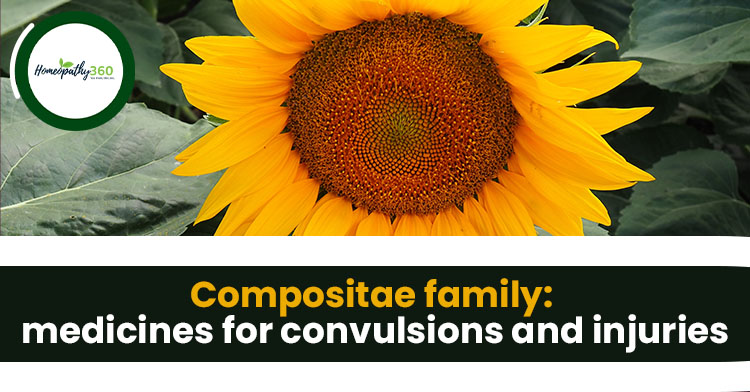
ABSTRACT
Compositae is the largest family of flowering plants with more than 1600 genera and 22000 species. It has many economic uses in foods, cosmetics, and pharmaceutics. However, the Compositae family is now renamed as Asteraceae family. Literature reports numerous medicinal benefits of Compositae family medicines. Compositae family medicines are useful in illnesses like convulsion, injury, fever, gastrointestinal disorders. In this article, attempt is made to reflect the indications of medicines of Compositae family for treatment of convulsions and injuries.
KEYWORDS: Compositae family, convulsions, injuries
INTRODUCTION
More than half of population in developing countries depends on natural medication preferably from plant kingdom for treatment of different sicknesses. Compositae family is now known as asteraceae family. Its name is derived from the structure of its inflorescences, in the form of flower head [1]. It is the largest family in plant kingdom on earth, commonly referred as aster, daisy, compositae or sunflower family. The compositae were first described in the year 1740. This family has a wide spread distribution, from subpolar to tropical regions in a wide variety of habitats. Most species of compositae family are annual, biennial, or perennial herbaceous plants, some are shrubs and vines [2]. Compositae family medicines are used for treatment of convulsions, injuries, gastrointestinal disorders, febrile disorders, genitourinary disorders, etc. Out of all these conditions, as revealed from the homoeopathic literature supported by clinical experiences, the medicines of compositae family are widely used for treatment of convulsions and injuries.
COMPOSITAE FAMILY
Commonly used homoeopathic medicines in Compositae family are- Abrotanum, Absinthium, Arnica montana, Artemisia vulgaris, Bellis perennis, Blumia odorata, Calendula officinalis, Carduus marianus, Matricaria chamomilla, Chrysanthemum, Cina maritima, Cineraria maritima, Echinacea, Erigeron candensis, Eupatorium perfoliatum, Gnaphallium, Grindelia robusta, Helianthus annuus, Guaco, Lactusa verosa, Liatris spicata, Millefolium, Parthenium, Santonine, Polymina uvedelia, Senecio, Solidago virga, Taraxacum officinale, Silphium, Tanacetum vulgare, Wyethia helenoides [3].
Characteristic physical symptoms
- Haemorrhagic tendency: hemorrhage from all orifices and mucus membranes of the body, ecchymosis, internal bleeding, haemorrhage from relaxed blood vessel. Blood is profuse, bright red, painless fluid.
- Oversensitiveness arising from abuse of coffee and narcotics.
- Marasmus: ascending type of marasmus, wasting inspite of voracious appetite.
- Soreness: sore, lame, bruised feeling of affected parts with congestion. Hypersensitivity to touch.
- Convulsions: after suppression of menses, epilepsy after puberty.
Mental symptoms
- Very anxious, extremely nervous, aversion to work.
- Cannot tolerate contradiction, unsatisfied all the time.
- Kleptomania, somnambulism, irritability aggravated by noise.
- Hysteria in females during menses. Fear of accidents, sees dead bodies.
General modalities [3]
- Aggravation: Damp cloudy weather, touch, motion, cold air, drinking, injury, evening, night, suppressed discharges and music.
- Amelioration: Continued motion, lying on abdomen, discharges, profuse sweating, rest, open air.
On the basis of pathogenesis, the medicines of compositae family can be divided into following small groups [3]:
- Injury group,
- Convulsive group,
- Gastrointestinal tract group,
- Genitourinary tract group,
- Febrile group
- Respiratory group
- Glands group
Physiological and toxicological actions– stimulants, vulnerary stomachic, anthelmintic, tonic, astringent, anti-inflammatory, anti-bacterial, narcotic, diaphoretic, emmenagogue.
Clinical conditions– trauma, convulsion, fever, worms, respiratory and gastrointestinal affections, haemorrhage [3].
Medicines of compositae family for convulsion
Cina maritima, Matricaria chamomilla, Artemisia vulgaris, Abrotanum, Absinthium, Tanacetum.
Common features [3]
- Convulsion occurring during the time of dentition, after anger, during menses.
- Convulsions with trembling, biting of tongue, tremors, chorea, opisthotonos, giddiness. There may or may not be loss of consciousness.
- Commonly affecting children- emaciation in spite of eating well, worms, convulsion, emotional and temperamental oversensitivity.
- Children are cross, irritable, very touchy, ugly in behavior, dissatisfied, capricious and don’t want to be touched or looked at.
- Mental irritability, nervousness, excitability, restlessness.
- Sadness, mental depression, thinking difficult, loss of comprehension, weak memory.
- Anxious dreams with restless sleep.
Differentiating features
Abrotanum [4,5]
- < conversation, mental effort.
- Wasting of lower extremities, ascending marasmus.
- Metastasis of rheumatism, from joint to spine.
- Suited to cases of suddenly appearing spinal inflammation and chronic myelitis.
Absinthium
- Convulsions preceded by trembling. Vertigo with tendency to fall backward [6].
Artemisia vulgaris [4,6]
- Patient is excitable and irritable before the attack of epilepsy.
- Epilepsy without aura. After fright, grief, blow in the head, menstrual disturbance, masturbation and teething.
- Convulsive diseases of childhood and girls at puberty.
Chamomilla [4,5,7,8]
- Convulsions caused by anger and downward motion; oversensitiveness after abuse of coffee or opium; worse from downward motion and better from being carried.
- Epileptic convulsions with retraction of thumb preceded by colic, followed by lethargic state. Urgent inclination to remain lying down.
- A child neither walks nor wants to be carried in the arms.
- Convulsions in the back, head thrown backwards; stiffness of the body.
- Chamomilla is useful in convulsions of children after any emotion.
- Convulsions of children from nursing, after a fit of anger in mother.
Cina maritima [4-7]
- Due to irritation from worms, child may get an attack of convulsion.
- Nocturnal epileptic convulsions, followed by headache with or without consciousness with cries, bending backwards of back and violent movement of hands and feet.
- Sudden inward jerking of fingers of right hand; child stretches out feet spasmodically. Left foot in constant spasmodic motion.
- Abdominal pain ending in convulsion.
- As a result of primary action on the abdominal ganglia, the reflex symptoms we get are: convulsive twitching and jerking of limbs and violent spasms, usually of tonic character.
Tanacetum vulgare [4-6]
- Chorea and reflex spasm from worms.
- Abnormal lassitude; nervous tired feeling. Half dead, half alive feeling.
- Trembling, convulsions, clonic spasms; coming instantenouosly and lasting a minute; slight tremor of arms, arms are thrown forward and at right angles to the body, forearm supinated, hands bent at right angles, fingers straight, slightly bent on hands, points of fingers nearly in contact; bites tongue in convulsion, sensation of throb through whole frame.
Medicines of compositae family for injuries
Arnica montana, Bellis perennis, Calendula officinalis, Echinacea angustifolia, Millefolium
Common features [3]
- Bad effects of injury, recent or remote and injury in any form.
- Injury to muscles, connective tissues, joints, mainly causing inflammation.
- Sepsis, suppuration, rheumatism, tumors, miscarriage.
- Injured nerves produce extreme pain, soreness, aching, bruised sensation.
- Weak and relaxed vessels of deeper organs produce profuse hemorrhage, ecchymosis and varicose veins.
- Overuse of any organ; excessive sexual indulgence produces deep seated affections.
- Mind- a state of fear, fright, nervousness, sleeplessness or nightmares after accidents, injuries.
- Fear of being approached or touched.
Differentiating features
Arnica montana [5,6,8,9]
- Specially adapted to those who remain long impressed by even slight mechanical injuries
- Sore, lame, bruised feeling all through the body, as if beaten; traumatic affections of muscles; conjunctival or retinal hemorrhage, with extravasation, from injuries or cough.
- After injuries from blunt instruments.
- Meningitis after mechanical or traumatic injuries; from fall, concussions of brain etc.
- Marked effect on blood, affects venous system, including stasis, ecchymosis and hemorrhage.
- Tendency to hemorrhage and low-grade fever.
- Relaxed blood vessels, black and blue spots.
- It affects the walls of blood vessels, particularly of the capillaries, so that dilatation of small vessels and extravasation of blood takes place. This weakening of capillary wall which admits of extravasation of blood explains the applicability of Arnica to trauma.
- The acute injuries for which Arnica is useful are simple bruises in which there are well marked ecchymoses, concussion of brain or spine or of both.
- No matter what the disease may be, whether of brain, eyes, lungs or nerves, if the injury is the exciting cause, the administration of Arnica is proper.
- In the chronic effects of injury Arnica may be used, when diseases may be traced to a traumatic origin.
- Arnica is a very important remedy in injuries, bruises, shocks, injuries of joints, injuries of back with lameness and soreness.
Bellis perennis [4,6]
- Acts on muscular fibres of blood vessels.
- First remedy for injury to deeper tissues, after major surgical work.
- Sore bruised feeling in the pelvic region.
- Stasis and fag are the keynote of the remedy.
Calendula officinalis [4,8]
- Indicated in lacerated and suppurating wounds.
- It is the homoeopathic antiseptic.
- Unlike Arnica, it has no irritating property capable of producing erysipelas. Therefore, suitable to all cases of injury when the skin is broken.
- Traumatic affections, to secure union by first intention and prevent suppuration.
- In all cases of loss of soft parts when union cannot be effected by means of adhesive plaster; external wounds with or without loss of substance; torn and jagged looking wounds; post-surgical operations; to promote healthy granulation and prevent excessive suppuration and disfiguring scars.
- Traumatic and idiopathic neuroma; neuritis from lacerated wounds; exhausted from loss of blood and excessive pain.
- Rupture of muscles or tendons; lacerations during labor; wounds penetrating articulations with loss of synovial fluids.
Cineraria maritima [4,6]
- Traumatic affections of eye.
- Cures traumatic cataract, senile cataract and corneal opacities.
Echinacea angustifolia [4,6]
- Used locally, as a cleansing and anti-septic wash.
- Snake bites, bites and stings in general.
- Lymphatic inflammation; crushing injuries.
- Irritation from insect bite and poisonous plants.
- Drowsiness is a marked feature.
- There is much chilliness and sensitiveness to cold, aggravation from exposure to cold air.
Erigeron canadense [4,6]
- It is a good medicine for hemorrhage, which is profuse and bright red.
Millefolium [4,6]
- An invaluable remedy for various types of hemorrhages;
blood bright red.
- Millefolium is suited to all wounds which bleed profusely; sprain and over-lifting.
- Bad effects of falling from a height; overlifting.
- After surgery for calculi.
- Haemorrhages are chiefly florid and bright red.
Conclusion
Hence, the medicines of compositae family prove to be efficacious in the treatment of convulsions and injuries.
REFERENCES
- Lopes DCDXP, Oliveira TB, Vicosa AL, Valverdo SS, Junior ER. Anti- Inflammatory Activity of the Compositae Family and Its Therapeutic Potential. Planta Med. 2021; 87:71-100.
- Wikipedia contributors. Asteraceae [Internet]. Wikipedia, The Free Encyclopaedia; 2022 Oct 18, 02:00 UTC
. Available from: https://en.wikipedia.org/w/index.php?title=Asteraceaeandoldid=1116734040.
- Patil JD. Group Study in Homoeopathic Materia Medica.2nd ed. New Delhi: B Jain Publishers(P)Ltd.; 2018.
- Clarke JH. A Dictionary of Practical Materia Medica. Reprint ed. New Delhi: B Jain Publishers(P)Ltd.; 2005.
- Farrington EA. Clinical Materia Medica. 4th ed. Revised and enlarged. New Delhi: B Jain Publishers(P)Ltd.; 1993.
- Boericke W. New Manual of Homoeopathic Materia Medica and Repertory.9th ed. New Delhi: B Jain Publishers(P)Ltd.; 2016.
- Mondal TC. Textbook of Homoeopathic Materia Medica. 2nd ed. Kolkata: Books and Allied (P) Ltd.;2005
- Allen HC. Keynotes Rearranged and Classified with Leading remedies of the Materia Medica.10th ed. Delhi: B Jain Publishers(P)Ltd.; 2005.
Kent JT. Lectures on Homoeopathic Materia Medica. Reprint ed. New Delhi: B Jain Publi
About Author:
Purnashashi Pani1*, Bijayalakshmi Behera2, Chaturbhuja Nayak3
1 Homoeopathic Medical Officer (on deputation to post of Reader), Department of Materia Medica, Dr. AC Homoeopathic Medical College and Hospital (DACHMCH), Bhubaneswar, Odisha, India.
2MD (Hom.), Part-II, Department of Materia Medica, Dr. Abhin Chandra Homoeopathic Medical College and Hospital, Bhubaneswar, Odisha, India.
3 Formerly: Director General of Central Council for Research in Homoeopathy, Ministry of AYUSH, Govt. of India, New Delhi; President of Homoeopathy University, Jaipur, Rajasthan and Principal-cum-Superintendent, DACHMCH, Bhubaneswar, Odisha, India.





